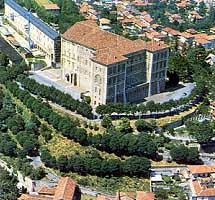 |
 |
 |
 |
 |
 |
 |
 |
 |
|
A Jacobite Gazetteer - Italy
Rivoli - Castello |
The town of Rivoli is located twelve kilometres west of Turin. The castle was owned by the House of Savoy from the thirteenth to the nineteenth centuries. In October 1673, Mary Beatrice, wife of James, Duke of York (later King James II and VII) visited the castle on her way from Modena to England to meet her new husband. Duke Charles Emanuel II of Savoy guided Mary Beatrice around the castle (without, however, revealing his identity to his guest). 1 In 1792 King Victor Amadeus III of Sardinia gave the castle of Rivoli to his younger son Victor Emanuel, Duke of Aosta (later King Victor). Over the next eight years much of the castle was renovated under the direction of Carlo Randoni. The decoration of Victor's apartment on the second floor of the castle dates from this time. 2 At the death of King Victor in 1824, the castle was inherited by his four living daughters (Queen Mary III and II and her younger sisters). On April 10, 1844, the Duchess of Lucca, the Empress Maria Anna of Austria, and their nephew the Duke of Calabria (only son and heir of Queen Maria Christina of the Two Sicilies) ceded their rights to the four children of Queen Mary (who herself had died in 1840). 3 The physical condition of the castle, however, declined; built as a pleasure palace, it required huge funds to maintain. Part of the property was rented out to the local town in 1860, and in 1883 the entire complex was sold to the town for 100,000 lire. 4 Among the rooms of particular interest are the "Sala di udienza o dei putti" (room 21) which served as the bedroom for Queen Mary III and II when she was a child; the "Sala del sorgere del giorno o da letto" (room 22) which was the bedroom of her mother (later Queen Maria Teresa) when Duchess of Aosta; the "Sala del velo" (room 25) which was the dressing room of the Duchess of Aosta; and the "Sala dei falconieri" (room 26) which was King Victor's dressing room. The ceiling decoration of the "Sala di Carlo Emanuele I" (room 33) - a celebratory scene dedicated to King Victor - has now vanished. 5 In 1978 it was decided to install a museum of contemporary art in the castle. Now restored to its former glory, the wall and ceiling decoration of the eighteenth-century rooms stands in sharp contrast to the pieces of modern art. Several of the most important paintings which were formerly in the castle are now displayed in the Municipio (the town hall) of Rivoli. A number of family portraits were transferred to the Castello di Racconigi in the 1920s. The museum (which includes King Victor's family apartment) is open Tuesday to Thursday from 10.00 a.m. to 5.00 p.m. and Friday to Sunday from 10.00 a.m. to 9.00 p.m. Admission: €6,50. Telephone: 39.011.9565222. Email: info@castellodirivoli.it. Website: www.castellodirivoli.it. Notes 1 Martin Haile, Queen Mary of Modena: Her Life and Letters (London: J. M. Dent, 1905),32-33. 2 Castello di Rivoli, Museo d'Arte Contemporanea: La Residenza Sabauda, La Collezione, edited by Ida Gianelli and Marcella Beccaria (Torino: Umberto Allemandi, 2003), 20. The decoration of the first floor of the castle and other parts of the second floor mostly dates from an earlier renovation in the 1710s by Filippo Juvarra. 3 Gianfranco Gritella Rivoli: Genesi di una Residenza Sabauda (Modena: Panini, 1986), 197. 4 Castello di Rivoli, 25. 5 Ibid., 391-399. |
|
This page is maintained by Noel S. McFerran (noel.mcferran@rogers.com) and was last updated January 7, 2007. |
